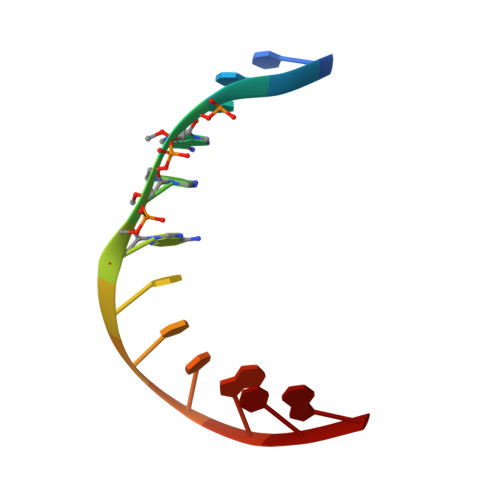The solution structure of [d(CGC)r(amamam)d(TTTGCG)]2.
Tsao, Y.P., Wang, L.Y., Hsu, S.T., Jain, M.L., Chou, S.H., Huang, C., Cheng, J.W.(2001) J Biomol NMR 21: 209-220
- PubMed: 11775738
- DOI: https://doi.org/10.1023/a:1012924932513
- Primary Citation of Related Structures:
1L3M - PubMed Abstract:
The solution structure and hydration of a DNA.RNA hybrid chimeric duplex [d(CGC)r(amamam)d(TTTGCG)]2 in which the RNA adenines were substituted by 2'-O-methylated riboadenines was determined using two-dimensional NMR, simulated annealing, and restrained molecular dynamics. Only DNA residue 7T in the 2'-OMe-RNA.DNA junction adopted an O4'-endo sugar conformation, while the other DNA residues including 3C in the DNA.2'-OMe-RNA junction, adopted C1'-exo or C2'-endo conformations. The observed NOE intensity of 2'-O-methyl group to H1' proton of 4am at the DNA.2'-OMe-RNA junction is much weaker than those of 5am and 6am. The 2'-O-methyl group of 4am was found to orient towards the minor groove in the trans domain while the 2'-O-methyl groups of 5am and 6am were found to be in the gauche (+) domain. In contrast to the long-lived water molecules found close to the RNA adenine H2 and H1' protons and the methyl group of 7T in the RNA-DNA junction of [d(CGC)r(aaa)d(TTTGCG)]2, there were no long-lived water molecules found in [d(CGC)r(amamam)d(TTTGCG)]2. This is probably due to the hydrophobic enviroment created by the 2'-O-methylated riboadenines in the minor groove or due to the wider minor groove width in the middle of the structure. In addition, the 2'-O-methylation of riboadenines in pure chimeric duplex increses its melting temperature from 48.5 degrees C to 51.9 degrees C. The characteristic structural features and hydration patterns of this chimeric duplex provide a molecular basis for further therapeutic applications of DNA.RNA hybrid and chimeric duplexes with 2'-modified RNA residues.
- Department of Life Science, National Tsing Hua University, Hsinchu, Taiwan, Republic of China.
Organizational Affiliation:
















